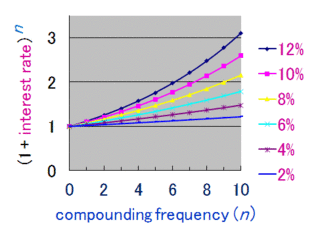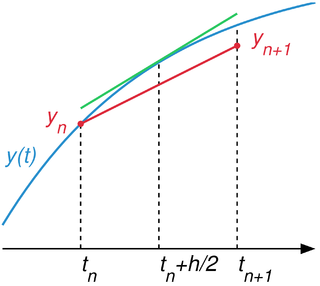Formula
CAGR is defined as:
where is the initial value, is the end value, and is the number of years.
Actual or normalized values may be used for calculation as long as they retain the same mathematical proportion.
Compound annual growth rate (CAGR) is a business, economics and investing term for the geometric progression ratio that provides a constant rate of return over the time period. [1] [2] CAGR is not an accounting term, but it is often used to describe some element of the business, for example revenue, units delivered, registered users, etc. CAGR dampens the effect of volatility of periodic returns that can render arithmetic means irrelevant. It is particularly useful to compare growth rates from various data sets of common domain such as revenue growth of companies in the same industry or sector. [3]
CAGR is equivalent to the more generic exponential growth rate when the exponential growth interval is one year.
CAGR is defined as:
where is the initial value, is the end value, and is the number of years.
Actual or normalized values may be used for calculation as long as they retain the same mathematical proportion.
In this example, we will compute the CAGR over a three-year period. Assume that the year-end revenues of a business over a three-year period, , have been:
| Year-End | 2004-12-31 | 2007-12-31 |
|---|---|---|
| Year-End Revenue | 9,000 | 13,000 |
Therefore, to calculate the CAGR of the revenues over the three-year period spanning the "end" of 2004 to the "end" of 2007 is:
Note that this is a smoothed growth rate per year. This rate of growth would take you to the ending value, from the starting value, in the number of years given, if growth had been at the same rate every year.
Verification:
Multiply the initial value (2004 year-end revenue) by (1 + CAGR) three times (because we calculated for 3 years). The product will equal the year-end revenue for 2007. This shows the compound growth rate:
For n = 3:
For comparison:
In contrast to CAGR, you cannot obtain by multiplying the initial value, , three times by (1 + AMR) (unless all annual growth rates are the same).
CAGR can also be used to calculate average annualized growth rates on quarterly or monthly data. The numerator of the exponent would be the value of 4 in the case of quarterly, and 12 in the case of monthly, with the denominator being the number of observations involved. [4]
These are some of the common CAGR applications:

In mathematics, the geometric mean is a mean or average which indicates a central tendency of a finite set of real numbers by using the product of their values. The geometric mean is defined as the nth root of the product of n numbers, i.e., for a set of numbers a1, a2, ..., an, the geometric mean is defined as
In economics and finance, present value (PV), also known as present discounted value, is the value of an expected income stream determined as of the date of valuation. The present value is usually less than the future value because money has interest-earning potential, a characteristic referred to as the time value of money, except during times of negative interest rates, when the present value will be equal or more than the future value. Time value can be described with the simplified phrase, "A dollar today is worth more than a dollar tomorrow". Here, 'worth more' means that its value is greater than tomorrow. A dollar today is worth more than a dollar tomorrow because the dollar can be invested and earn a day's worth of interest, making the total accumulate to a value more than a dollar by tomorrow. Interest can be compared to rent. Just as rent is paid to a landlord by a tenant without the ownership of the asset being transferred, interest is paid to a lender by a borrower who gains access to the money for a time before paying it back. By letting the borrower have access to the money, the lender has sacrificed the exchange value of this money, and is compensated for it in the form of interest. The initial amount of borrowed funds is less than the total amount of money paid to the lender.

Compound interest is interest accumulated from a principal sum and previously accumulated interest. It is the result of reinvesting or retaining interest that would otherwise be paid out, or of the accumulation of debts from a borrower.
The density of air or atmospheric density, denoted ρ, is the mass per unit volume of Earth's atmosphere. Air density, like air pressure, decreases with increasing altitude. It also changes with variations in atmospheric pressure, temperature and humidity. At 101.325 kPa (abs) and 20 °C, air has a density of approximately 1.204 kg/m3 (0.0752 lb/cu ft), according to the International Standard Atmosphere (ISA). At 101.325 kPa (abs) and 15 °C (59 °F), air has a density of approximately 1.225 kg/m3 (0.0765 lb/cu ft), which is about 1⁄800 that of water, according to the International Standard Atmosphere (ISA). Pure liquid water is 1,000 kg/m3 (62 lb/cu ft).
Future value is the value of an asset at a specific date. It measures the nominal future sum of money that a given sum of money is "worth" at a specified time in the future assuming a certain interest rate, or more generally, rate of return; it is the present value multiplied by the accumulation function. The value does not include corrections for inflation or other factors that affect the true value of money in the future. This is used in time value of money calculations.
Verlet integration is a numerical method used to integrate Newton's equations of motion. It is frequently used to calculate trajectories of particles in molecular dynamics simulations and computer graphics. The algorithm was first used in 1791 by Jean Baptiste Delambre and has been rediscovered many times since then, most recently by Loup Verlet in the 1960s for use in molecular dynamics. It was also used by P. H. Cowell and A. C. C. Crommelin in 1909 to compute the orbit of Halley's Comet, and by Carl Størmer in 1907 to study the trajectories of electrical particles in a magnetic field . The Verlet integrator provides good numerical stability, as well as other properties that are important in physical systems such as time reversibility and preservation of the symplectic form on phase space, at no significant additional computational cost over the simple Euler method.
In finance, the duration of a financial asset that consists of fixed cash flows, such as a bond, is the weighted average of the times until those fixed cash flows are received. When the price of an asset is considered as a function of yield, duration also measures the price sensitivity to yield, the rate of change of price with respect to yield, or the percentage change in price for a parallel shift in yields.
A price index is a normalized average of price relatives for a given class of goods or services in a given region, during a given interval of time. It is a statistic designed to help to compare how these price relatives, taken as a whole, differ between time periods or geographical locations.

In numerical analysis, a branch of applied mathematics, the midpoint method is a one-step method for numerically solving the differential equation,
In scattering theory, a part of mathematical physics, the Dyson series, formulated by Freeman Dyson, is a perturbative expansion of the time evolution operator in the interaction picture. Each term can be represented by a sum of Feynman diagrams.
In orbital mechanics, mean motion is the angular speed required for a body to complete one orbit, assuming constant speed in a circular orbit which completes in the same time as the variable speed, elliptical orbit of the actual body. The concept applies equally well to a small body revolving about a large, massive primary body or to two relatively same-sized bodies revolving about a common center of mass. While nominally a mean, and theoretically so in the case of two-body motion, in practice the mean motion is not typically an average over time for the orbits of real bodies, which only approximate the two-body assumption. It is rather the instantaneous value which satisfies the above conditions as calculated from the current gravitational and geometric circumstances of the body's constantly-changing, perturbed orbit.
In finance, the terminal value of a security is the present value at a future point in time of all future cash flows when we expect stable growth rate forever. It is most often used in multi-stage discounted cash flow analysis, and allows for the limitation of cash flow projections to a several-year period; see Forecast period (finance). Forecasting results beyond such a period is impractical and exposes such projections to a variety of risks limiting their validity, primarily the great uncertainty involved in predicting industry and macroeconomic conditions beyond a few years.

In mathematics and computational science, the Euler method is a first-order numerical procedure for solving ordinary differential equations (ODEs) with a given initial value. It is the most basic explicit method for numerical integration of ordinary differential equations and is the simplest Runge–Kutta method. The Euler method is named after Leonhard Euler, who first proposed it in his book Institutionum calculi integralis.
In finance, return is a profit on an investment. It comprises any change in value of the investment, and/or cash flows which the investor receives from that investment over a specified time period, such as interest payments, coupons, cash dividends and stock dividends. It may be measured either in absolute terms or as a percentage of the amount invested. The latter is also called the holding period return.
The doubling time is the time it takes for a population to double in size/value. It is applied to population growth, inflation, resource extraction, consumption of goods, compound interest, the volume of malignant tumours, and many other things that tend to grow over time. When the relative growth rate is constant, the quantity undergoes exponential growth and has a constant doubling time or period, which can be calculated directly from the growth rate.
In gas chromatography, the Kovats retention index is used to convert retention times into system-independent constants. The index is named after the Hungarian-born Swiss chemist Ervin Kováts, who outlined the concept in the 1950s while performing research into the composition of the essential oils.
Earnings growth is the annual compound annual growth rate (CAGR) of earnings from investments.
The time-weighted return (TWR) is a method of calculating investment return, where returns over sub-periods are compounded together, with each sub-period weighted according to its duration. The time-weighted method differs from other methods of calculating investment return, in the particular way it compensates for external flows.
The public market equivalent (PME) is a collection of performance measures developed to assess private equity funds and to overcome the limitations of the internal rate of return and multiple on invested capital measurements. While the calculations differ, they all attempt to measure the return from deploying a private equity fund's cash flows into a stock market index.
In investment, an annuity is a series of payments made at equal intervals. Examples of annuities are regular deposits to a savings account, monthly home mortgage payments, monthly insurance payments and pension payments. Annuities can be classified by the frequency of payment dates. The payments (deposits) may be made weekly, monthly, quarterly, yearly, or at any other regular interval of time. Annuities may be calculated by mathematical functions known as "annuity functions".